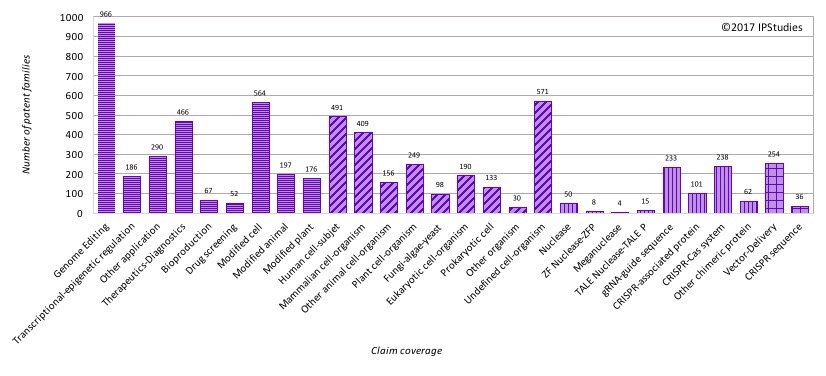Emmanuelle Charpentier and Jennifer Doudna just received a few hours ago the Nobel prize in Chemistry 2020 for “the development of a method of genome editing”, namely their 2012 discovery of the CRISPR/Cas9 genetic scissors which basically enables to “cut and paste” DNA. This scientific discovery has fueled an unprecedented biotechnology development in the past 8 years. When we started to analyze the genome editing patent landscape in Spring 2014, there were only 96 patent families(*) in our records in relation with CRISPR. We have now more than 7400 in our latest records – and adding an average of 200 more every month in 2020. What does this data tell us on who has taken advantage in engineering new life sciences solutions out of this amazing scientific discovery, now confirmed worth a Nobel Prize?
Continue readingTag: Cas9
Recent developments in the CRISPR patent landscape
The CRISPR patent landscape keeps on developing with now an average of two new patent publications every day. We have now searched, reviewed and categorized 1198 patent families in our February 2016 CRISPR patent analytics data set. The recent conclusions by the USPTO on the CRISPR pioneering patent interference has received significant media attention and finally confirmed the diversity of the CRISPR licensing landscape. We have provided our 2017 key findings to a number of analysts in the field, and are working hard to keep on extracting and sorting meaningful CRISPR patent coverage information for our customers on a monthly basis.
The IPStudies 2017 CRISPR patent landscape is out, don’t miss it!
The CRISPR patent landscape keeps on developing at an increasing pace in 2017, with now up to three new patent families published every day! We have searched, reviewed and categorized more than 1146 patent families, now surveyed in our just released 2017 CRISPR patent landscape report.
CRISPR patent analytics monthly update
The CRISPR patent landscape keeps on developing with in average a new patent publication every day. We have now searched, reviewed and categorized more than 850 patent families in our CRISPR patent analytics database.
More CRISPR interfering inventors may come from Vilnius
Earlier this month, we were interviewed by The Scientist regarding the side inventorship dispute between Feng Zhang and Luciano Marraffini on some of the Broad patent applications. Public registers at the USPTO, WIPO and the EPO expose further details of the otherwise un-publicized legal battles for invention ownership between their employers (the Broad Institute of Harvard and MIT and Rockfeller University), back from the 2012-2013 early filings.

